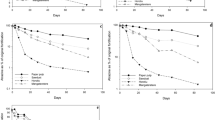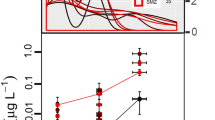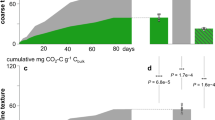Abstract
PARTITION between soil and water of organic compounds that do not ionize in the pH range 4–8 is closely correlated with the soil's content of organic matter. Lambert1 and Furmidge amd Osgerby2 have expressed sorption in terms of partition coefficients between soil organic matter and water, neglecting mineral constituents. Some investigators have also reported inverse correlations between water solubility and sorption on soil whereas others have found no relationship2,3. Little is known about the mechanisms of sorption on soil, but apparently only a small fraction of the surface is responsible for the sorption of certain herbicides3. I have attempted to learn more about sorption mechanisms by studying how changes in the chemical structure of related compounds affect sorption.
This is a preview of subscription content, access via your institution
Access options
Subscribe to this journal
Receive 51 print issues and online access
$199.00 per year
only $3.90 per issue
Buy this article
- Purchase on SpringerLink
- Instant access to full article PDF
Prices may be subject to local taxes which are calculated during checkout
Similar content being viewed by others
References
Lambert, S. M., J. Agric. Food Chem., 15, 572 (1967).
Furmidge, C. G. L., and Osgerby, J. M., J. Sci. Food Agric., 18, 269 (1967).
Hance, R. J., Weed Res., 5, 98 (1965).
Barlin, G. B., and Perrin, D. D., Quart. Rev. Chem. Soc., 20, 75 (1966).
Fujita, T., Iwasa, J., and Hansch, C., J. Amer. Chem. Soc., 86, 5175 (1964).
Hance, R. J., J. Agric. Food Chem., 17, 667 (1969).
Hance, R. J., Nature, 214, 630 (1967).
Author information
Authors and Affiliations
Rights and permissions
About this article
Cite this article
BRIGGS, G. Molecular Structure of Herbicides and their Sorption by Soils. Nature 223, 1288 (1969). https://doi.org/10.1038/2231288a0
Received:
Issue date:
DOI: https://doi.org/10.1038/2231288a0



